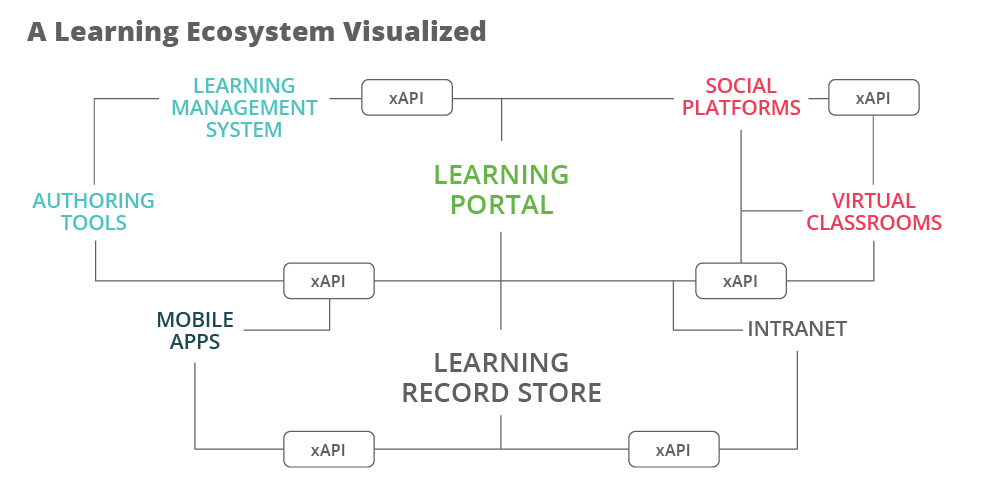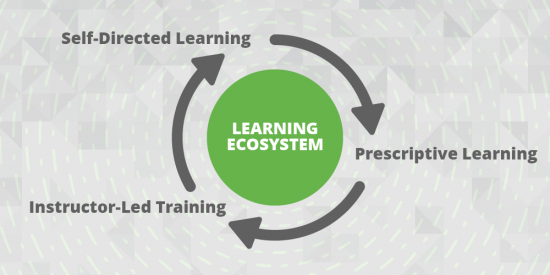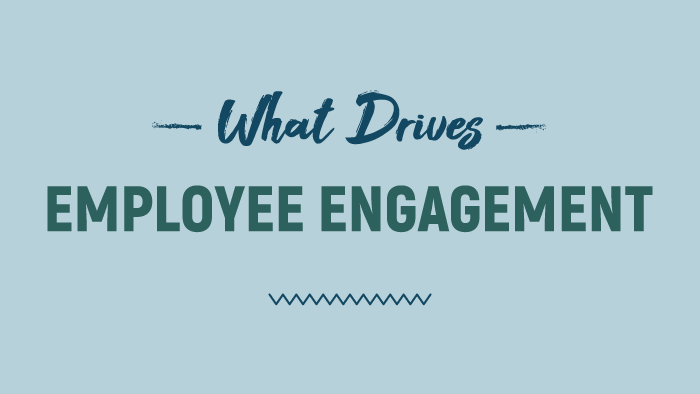Over the last few years, we have seen a rapid change in the learning and development world. Gone are the days when employees solely cared about completing their mandatory annual compliance and workplace safety training. Now they are looking for opportunities to expand their skills and grow in their roles. But that cannot be achieved with just live, virtual, or pre-recorded instructor-delivered sessions.
To keep up with the speed of change, organizations need to build a learning ecosystem where employees are provided opportunities to pursue independent and self-directed learning and leverage all the capabilities their learning management system (LMS) provides.
Thomas Shayon Harrell shared his thoughts about this industry shift on various podcasts and blogs, including The BizLibrary Podcast. When he began his research into this concept several years ago, only a few results appeared. That’s no longer the case today.
And yet, the question remains: what is a learning ecosystem, and why should L&D professionals care?
What Is a Learning Ecosystem?
A learning ecosystem moves your organization and its employees forward through continuous learning, education, and development. The ecosystem extends well beyond the walls of just using an LMS for assigned training programs, but rather it supercharges employees’ self-directed learning.
The learning ecosystem takes what may seem like disparate modalities and unconnected systems – instructor-led training, virtual instructor-led training, self-guided learning, self-directed learning, and/or attending an in-person training event – and ties them into an elegant learning solution.
This ecosystem captures learning where it happens (including your existing LMS) and adds progress to employees’ learner records for tracking, performance management, and record-keeping.
Three elements of learning come to mind when we think of a healthy learning ecosystem: “fast,” “frictionless,” and “friendly.”
Here are various definitions from others in the L&D field:
“A learning and performance ecosystem enhances individual and organizational effectiveness by connecting people and supporting them with a broad range of content, processes, and technologies to drive performance.” – The eLearning Guild
“The symbiotic learning relationship between an employee and an organization.” – Harvard Business Review
“A learning ecosystem is a collection of people, processes, and tools that deliver, integrate, and support the L&D function across your organization. Every organization has a learning ecosystem, just like every business has a culture, whether it was formed intentionally or not.” – Rose Benedicks of Training Industry, Inc.
To wrap this section up, we’re asking you to think about your own organization and what a holistic approach to learning might look like within it.
Imagine this without limitations.
What would you build to enable learning, help your company meet and exceed its business goals, and serve your team members to enhance their on-the-job skills and personal lives?
You don’t need to follow a template for this – many practices in learning and development have different applications from one company to the next.
For one of our clients, SeneGence, it was creating monthly training assignments within BizLMS dedicated to skills that matched their company’s values to promote upward mobility. For another, Quala, it was implementing a life skills program meant to educate employees with BizLibrary off-the-shelf content and mentor meetups on how to improve holistically.
Whatever your imagination just conceived, that’s your learning ecosystem.
Key Element #1: Mindset Shift
First, learning ecosystems aren’t new, but like many things in the workplace learning profession, we’ve taken something old and made it new.
What we mean by that is what Rose Benedicks mentioned above: “Every organization has a learning ecosystem, just like every business has a culture, whether it was formed intentionally or not.”
We all use some type of structure to deliver learning to our employees, and we all exploit different modalities to make it happen.
But…
The world is an ever-changing place.
If you’ve been in the L&D profession for 20 years or more you remember that as a learner, your only option was to attend a live training at work, and you took your agenda with you as a reminder.
Email was a new thing. At home, your choice of television was limited.
The world was a different place.
Today, we have access to hundreds of channels of entertainment, music, and communication options, all glued to the palm of our hands. The same applies to younger professionals looking for jobs with our companies — they were raised in a world where they’ve only known this level of choice in many areas of their lives.
This presents a challenge to the workplace learning professional.
Harrell used to be a Microsoft Certified Trainer, and will never forget an experience during one of his training sessions.
One of his learners asked a question, and he didn’t have the answer on hand, so he did what any trainer worth their salt would have done: wrote the question down on his whiteboard. Before he could finish writing it, another learner went online, typed in the question, and offered up the answer to the entire class.
That day he knew his L&D role was undergoing a tectonic shift.
“We must step up to the plate and redefine how we help our team members and companies thrive in the competitive marketplaces of this new technological age of frictionless self-service.”
The first key element is the changing of our mindsets as workplace learning professionals. We must embrace the reality that the employees we support don’t need to wait for us to deliver training to help them solve a business problem or enhance their skills.
Technology has democratized our profession, just like every other profession and industry. Now, we must step up to the plate and redefine how we help our team members and companies thrive in the competitive marketplaces of this new technological age of frictionless self-service.
This can start with educating employees on the vast amount of learning and development content they have at their fingertips within their organization’s LMS rather than automatically going to Google or YouTube to find something out.
But that doesn’t mean we have to wholesale abandon everything we’ve done. That is, the proposition isn’t an “either/or” deal; it’s an issue of finding the right balance of what “and” looks like in your organization.
A mindset shift is the first element to building a learning ecosystem because without it, a learning leader wouldn’t even be open to new possibilities.
Key Element #2: Let’s Think “And”
Our thesis is that L&D professionals need to augment what we do as learning professionals. Below is a checklist to illustrate the tasks that are required of modern and effective training program managers.
- Sound instructional design (still needed)
- Various delivery modalities (still needed)
- Building learning to help your organization reach its business goals faster (still needed)
- A different way of approaching learning (now needed)
Instead of asking yourself how you can give employees a frictionless learning experience that interferes with their work as little as possible, ask how you can enable learning experiences that empower your employees.
The mindset shift to the “and” elements means embracing new methods rather than being the center of your employees’ learning universe. It’s about creating an environment that allows them to learn, even if that means you’re not actively delivering the training content you previously have throughout your career.
“Ask how you can enable learning experiences that empower your employees.”
It can be difficult to keep everyone connected and invested in remote and hybrid organizations.
See how Challenge Unlimited delivers a high-quality and consistent learning experience for all of its geographically dispersed employees.
Key Element #3: Say Yes to Technology
Using the classroom feature in BizLMS is a small and simple example of enabling learning, which brings us to our next key element!
Yes, technology is part of the learning ecosystem. But again, leveraging technology to enhance the effectiveness of training isn’t new.
And just like in the past, as L&D practitioners, we must thoughtfully use tech to help the business and learners. Technology must fit into the broader business and learning strategies to have the intended impact.
Technology now holds the promise of capturing and logging an employee’s learning, regardless of where it takes place. And with BizLibrary’s new BizLMS Administrator’s Dashboard, capturing insightful learner data has never been easier.
Here’s a practical use case to demonstrate how organizations can use a learning ecosystem to address organizational challenges to improve the business internally and externally:
Case Study
US Eagle identified this employee retention challenge through feedback from their employees letting them know they wanted a development program that was different than what was already available.
Their employees were getting tired of the long, complicated, credit union and compliance training. While the training was vital to gaining insight into the organization and performing their job up to standards, the training and development team recognized that the employees needed a boost in their skills. So, the search for something faster, lighter, educational, and engaging began.
During their search process, they came across BizLibrary’s BizSkills platform the first and only upskilling platform that provides your workforce with personalized training and career growth for each unique employee. They knew the solution would be the perfect fit for them to build out a stand-out skills development program for their people.
Launching BizSkills became the start of creating a culture of continuous learning at US Eagle. When new hires begin, they are assigned their BizSkills role and content mapped to the specific skill proficiencies needed to excel to get them comfortable in the platform on day one.
Beyond following the learning paths within BizSkills, employees also began consuming additional elective learning to fuel their passion for professional development. Banik also sends out monthly marketing messages that highlight new content available from BizLibrary as well as a skill of the month with recommended courses if employees are interested.
With the help of BizSkills’ skills interest feature, admins easily track what their employees are learning and can help guide development conversations when discussing future roles.
Since implementing BizSkills in their organization, US Eagle has experienced better business outcomes and improved employee retention.
It’s worth mentioning that since US Eagles implementation, BizSkills has evolved from a stand alone upskilling platform to an integrated feature in our LMS that is available to all our customers!
The point we want to make here is that the ecosystem enables learning professionals to support learners in ways we couldn’t before, and all the core capabilities of this profession are still essential to what we can do within the context of this new technological age.
Creating Your Learning Ecosystem

The learning ecosystem you build to supercharge your organization so it can reach its business goals doesn’t have to resemble the image above. Maybe you’ll have more or fewer components. Remember, it depends on your company’s needs.
Giving our employees a learning experience that is fast, frictionless, and friendly doesn’t make us obsolete.
As L&D professionals and leaders, we must still bring to bear all our professional and technical prowess to give the ecosystem a human touch, even though elements of the experience will be as easy as watching a movie on Netflix. We still need to create, maintain, and update our learning ecosystems.
Let’s fully embrace this exciting time in L&D to deepen our rapport and reach out to our team members and executive leaders so that we can partner with them to achieve bigger goals in ways that we only dreamed of before.

